
Name
Classifications and Characteristics
| Plant Division | Angiosperms (Flowering Seed Plants) |
|---|---|
| Plant Growth Form | Herbaceous Plant |
| Lifespan (in Singapore) | Annual |
| Mode of Nutrition | Autotrophic |
Description and Ethnobotany
| Growth Form | It is an annual herb with a compact, open growth form. Although members of the species Cucurbita pepo are often vines, zucchini is typically produced by non-vining plants. |
|---|---|
| Foliage | Large leaves are palmately lobed and covered in prickly hairs. |
| Flowers | Male and female flowers can be differentiated by the flower stalk: male flowers are borne on slender stems, while female flowers occur on stout stems. |
| Fruit | The fruit, botanically classified as a pepo, is cylindrical and thin-skinned. |
| Cultivation | There are many cultivars which produce distinctly different types of zucchini. These cultivars may cross with one another to produce new types of offspring. Seeds can be sown individually 2.5 cm belowground. Alternatively, 6-8 seeds can be planted in a small mound and thinned to the strongest individual. Seeds may take 4 to 10 days to germinate. Depending on the varieties, the plant may take 45 to 50 days to mature. |
| Etymology | Courgette is the French word for zucchini. Zucchini is more commonly used in North America, while courgette is often used in the United Kingdom and France. |
| Ethnobotanical Uses | Edible Plant Parts : Edible Fruits, Edible Flowers Food (Fruit or Vegetable): It is a summer squash which is harvested before the fruit matures, as opposed to a winter squash which is allowed to mature before harvesting. The immature fruit is prepared as a cooked vegetable in a variety of ways, such as steaming, boiling and roasting. In Italy, the flowers are fried and stuffed with cheese. |
Fauna, Pollination and Dispersal
| Fauna Pollination Dispersal Associated Fauna | Bee-Attracting |
|---|
Plant Care and Propagation
| Light Preference | Full Sun |
|---|---|
| Water Preference | Moderate Water |
| Potential Problems | Zucchini plants are prone to powdery mildew and leaf diseases. Increase air circulation by providing plenty of room to grow and avoid wetting the leaves to reduce the likelihood of fungal and bacterial diseases. |
Floral (Angiosperm)
| Flower Colour(s) | Yellow / Golden |
|---|---|
| Flower Texture(s) | Wrinkled |
| Flower Grouping | Solitary |
| Flower Location | Axillary |
| Flower Symmetry | Radial |
| Individual Flower Shape | Funnelform / Funnel-shaped |
Image Repository
Others
| Master ID | 33970 |
|---|---|
| Species ID | 8386 |
| Flora Disclaimer | The information in this website has been compiled from reliable sources, such as reference works on medicinal plants. It is not a substitute for medical advice or treatment and NParks does not purport to provide any medical advice. Readers should always consult his/her physician before using or consuming a plant for medicinal purposes. |

.jpg)



